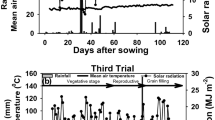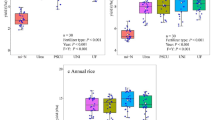Abstract
Data from 35 experiments with direct seeded rice, performed between 1981 and 1991 by national research institutes in five major rice growing countries of Europe were analyzed to estimate the average efficiency of fertilizer nitrogen (N). Pooled data from a four year regional survey (1984–1988) on rice-based farming systems in the Camargueregion (43° 20'–43° 40' N) in the south of France, were used to perform a similar analysis. Experimentation during two years (1989–1990) was carried out to assess the value of the N-utilization efficiency within the range of N-limited growth and to obtain information on the N-efficiency under controlled conditions.
At reduced basal dressing of N on soils with high soil organic matter content, the apparent N-recovery was estimated at 0.21 to 0.32 kg N uptake per kg N applied. Average agronomic efficiency ranged from 12 to 17 kg grain dry mass per kg N applied. High basal N-application on these soils resulted in yield loss. No consistent yield response to fertilizer-N input was found on soils with less than two percent organic matter, irrespective of fertilizer timing. These results confirm the important role of soil organic matter in rice cultivation.
An average apparent N-recovery of 0.18 was obtained with split application of N under controlled experimental conditions in the Camargue. Using a controlled release fertilizer, values of 0.58 and 32 kg.kg−1 were obtained for the apparent N-recovery and agronomic efficiency, respectively. Hence, disregarding the economic feasibility, considerable scope exists for improving N-efficiency in European rice cultivation.
Similar content being viewed by others
References
Anonymous (1984a) Directory of wetlands of international importance. IUCN conservation monitoring centre, Kew, UK. 271 p
Anonymous (1984b) Method 2.064. In: Williams S (ed) Methods of analysis (14th ed). Assoc Official Agr Chem, Washington. 1141 p
Barbier JM, Conesa AP, Mouret JC, Nougaredes B and Stutterheim NC (1990) Méthodes d'étude des facteurs et conditions limitant les rendements d'une culture: Applications au cas du riz en Camargue. Euroriza 1: 15–26
Barbier JM and Mouret JC (1992) Utilisation du concept d'itinéraire technique pour l'amélioration de la fertilisation azotée du riz irrigué. Cas des riziéres du sud de la France. Agron Trop 46: 295–303
Bilal IM, Henderson DW and Tanji KK (1979) N losses in irrigation return flows from flooded rice plots fertilized with ammonium sulphate. Agr J 71: 279–284
Cao ZH, De Datta SK and Fillery IRP (1984) Nitrogen-15 balance and residual effects of urea-N in wetland rice fields as affected by deep-placement techniques. Soil Sci Soc Am J 48: 203–208
Chauhan HS and Mishra B (1989) Fertilizer-use efficiency of amended urea materials in flooded rice. J Agric Sci Camb 112: 277–281
Craswell ET, De Datta SK, Obcemea WN and Hartantyo M (1981) Time and mode of nitrogen fertilizer application to tropical wetland rice. Fert Res 2: 247–259
Craswell ET and Vlek P G (1979) Fate of fertilizer nitrogen applied to wetland rice. In: Nitrogen and Rice, pp 175–192. IRRI, Manila
De Datta SK (1981) Principles and practices of rice production. John Wiley and Sons, New York. 618 p
De Datta SK, Fillery IRP and Craswell ET (1983) Results from recent studies on nitrogen fertilizer efficiency in wetland rice. Outlook in Agriculture 12:125–134
De Datta SK, Magnaye CP and Moomaw JC (1968) Efficiency of fertilizer nitrogen (15N-labelled) for flooded rice. 9th Int Congr Soil Sci Trans. pp 67–76.
Flinn JC, Mamaril CP, Velasco LE and Kaiser K (1984) Efficiency of modified urea fertilizers for tropical irrigated rice. Fert Res 5:157–174
Fujii T and Yazawa F (1989) Development of coated fertilizer (Ceracoat) In: Proceedings of the symposium on fertilizer, present and future, September 25–26, 1989, pp 101–108. Jap Soc Soil Sci Plant Nutr
Fujita T, Maeda S, Shibata M and Takahashi C (1989) Research and development of coated fertilizer: 78–100. In: Proceedings of the symposium on fertilizer, present and future, September 25–26, 1989, pp 78–100 Jap Soc Soil Sci Plant Nutr.
Humphreys E, Chalk PM, Muirhead WA, Melhuish FM and White RJG (1987) Effects of time of urea application on combine-sown Calrose rice in south-east Australia. III. Fertiliser nitrogen recovery, efficiency of fertilisation and soil nitrogen supply. Aust J Agric Res 38: 113–127
Keulen H van (1977) Nitrogen requirements of rice, with special reference to Java. Contr Centr Res Inst Agric Bogor 30. 67 p
Keulen H van (1982) Graphical analysis of annual crop response to fertiliser application. Agricultural Systems 9: 113–126
Kolhe SS and Mittra BN (1987) Direct and residual effect of slow release urea fertilizers in rice-wheat cropping systems. J Agric Crop Sci 158:190–194
Murayama N (1979) The importance of nitrogen for rice production In: Nitrogen and Rice, pp 5–23. IRR, Manila.
Oertli JJ (1980) Controlled release fertilizers. Fert Res 1: 103–123
Patnaik S (1965) N15 tracer studies on the transformation of applied nitrogen in submerged rice soils. Ind Acad Sci 61: 25–30
Racho VV and De Datta SK (1968) Nitrogen economy of cropped and uncropped flooded rice soils under field conditions. Soil Sc 105: 419–427
Rana DS, Singh B, Kapur ML and Bhandari AL (1984) Relative efficiency of new urea based nitrogen fertilizers for rice grown in a light textured soil. J Ind Soc Soil Sci 32: 284–287
Rao DLN (1987) Slow-release urea fertilisers - effect on floodwater chemistry, ammonia volatilization and rice growth in an alkali soil. Fert Res 13: 209–221
Reddy KR and Patrick Jr. WH (1976) Yield and nitrogen utilization by rice as affected by method and time of application of labelled nitrogen. Agron J 68: 965–969
Savant NK and De Datta SK (1982) Nitrogen transformations in wetland rice soils. Adv Agr 35: 241–302
Schmidt EL (1982) Nitrification in soil. In: Stevenson J R (ed) Nitrogen in Agricultural Soils. pp 253–288. ASA, CSSA, SSSA, Madison, Agronomy Monograph 22
Singh B and Katyal JC (1987) Relative efficacy of some new urea based nitrogen fertilizers for growing wetland rice on a permeable alluvial soil. J Agric Sci Camb 109: 27–31
Singh GR and Singh TA (1988) Leaching losses and use efficiency of nitrogen in rice fertilized with urea supergranules. J Ind Soc Soil Sci 36: 274–279
Stojanovic BJ and Broadbent FE (1956) Immobilization and mineralization rates of nitrogen during decomposition of plant residues in soil. Soil Sci Soc Am Proc 20: 213–218
Stutterheim NC and Barbier JM (1993) Growth and yield formation of irrigated, direct seeded rice (O. sativa L.) as determined by nitrogen uptake. Submitted to Field Crops Res
Tejeda HR, Hong CW and Vlek PLG (1980) Comparison of modified urea fertilizers and estimation of their availability coefficient using quadratic models. Soil Sci Soc Am J 44: 1256–1262
Vlek PLG and Byrnes BH (1986) The efficacy and loss of fertilizer N in lowland rice. Fert Res 9: 131–147
Wada G, Shoji S and Mae T (1986) Relationship between nitrogen absorption and growth and yield of rice plants. J A R Q 20: 135–145
Wells BR and Shockley PA (1975) Conventional and controlledrelease nitrogen sources for rice. Soil Sci Soc. Am Proc 39: 549–551
Wit CT de (1953) A physical theory on placement of fertilizers. Versl Landbouwk Onderz 59.4, Staatsdrukkerij, 's-Gravenhage: 71 p
Author information
Authors and Affiliations
Rights and permissions
About this article
Cite this article
Stutterheim, N.C., Barbier, J. & Nougaredes, B. The efficiency of fertilizer nitrogen in irrigated, direct seeded rice (O. sativa L.) in Europe. Fertilizer Research 37, 235–244 (1994). https://doi.org/10.1007/BF00748942
Received:
Accepted:
Issue Date:
DOI: https://doi.org/10.1007/BF00748942




